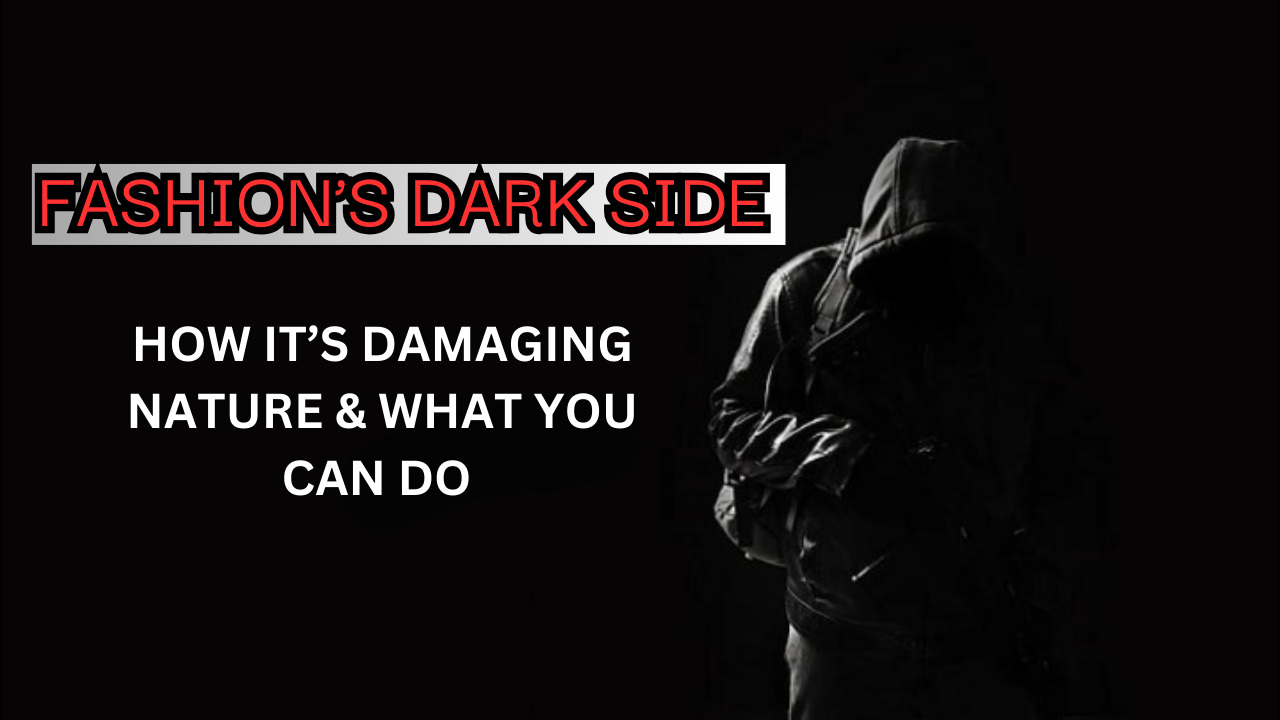The fashion industry is often celebrated for its creativity and influence, but beneath the glamour lies a darker truth. The rapid growth of fast fashion and unsustainable practices has made the fashion industry one of the largest contributors to environmental damage. This article explores the environmental impact of fashion, the consequences of these practices, and actionable steps you can take to make a difference.
Environmental Effects of the Fashion Industry:
The fashion industry has terrible environmental effects. From overconsumption of water to pollution and waste, the dark side of fashion is undeniable.
Water Use and Pollution:
Producing textiles such as cotton requires huge quantities of water. It takes about 10,000 liters of water to make a pair of jeans. Consumption and pollution are also huge problems. Textile dyeing is the second largest polluter of clean water, releasing toxic chemicals into rivers and lakes.
Greenhouse Gas Emissions:
The fashion industry accounts for 10% of the greenhouse gases emitted globally. Most of the fast fashion uses synthetic fibers. Polyester, one of such synthetic fibers, is made from fossil fuels. Once in the environment, they never decompose. They rather go on to pollute by releasing harmful microplastics.
Waste Generation:
Every year, millions of tons of clothing landfills. Fast fashion has promoted a “wear-and-dispose” culture, resulting in about 92 million tons of textile waste every year. The waste occupies valuable landfill space and releases methane, a potent greenhouse gas, as it decomposes.
Deforestation:
The demand for fabrics such as rayon and viscose is creating the alarming destruction of forests. Deforestation contributes to biodiversity loss and climate change.
Social Cost of Fashion:
The social cost of the fashion industry is also quite significant. While the environment is affected by this industry, the workers of garment factories, especially in developing countries, are exposed to poor working conditions, low wages, and exposure to chemicals that can be harmful. The need for cheap and fast production comes at the expense of human rights and dignity.
What You Can Do to Help:
As consumers, we are the ones who can help change things. Here’s what you can do today to reduce the negative influence of fashion on nature:
1. Buy Sustainable Brands
Buy only from brands that take the time to ensure their ethics and sustainability. Be sure to look for certifications, such as GOTS (Global Organic Textile Standard) and Fair Trade, to make sure your purchases meet environmental and social standards.
2. Buy Less, Choose Wisely:
Buy fewer, better-quality items that last longer. Select versatile items that can be worn in different ways so that the need for too many purchases is reduced.
3. Shop Second-Hand:
Thrift stores and online marketplaces sell a variety of second-hand clothing. Buying second-hand reduces demand for new production and gives clothes a second life.
4. Mend and Upcycle:
Instead of degrading damaged clothing, mend it or be creative in upcycling. Transform old garments into new and fashionable pieces, or make them into any household items.
5. Clothing Swaps:
Organize or participate in clothing swap events. This would refresh your wardrobe without feeding the landfill or supporting the fast fashion industry.
6. Wash Clothes Correctly:
Washing synthetic fabrics releases microplastics into waterways. Use a microfiber-catching laundry bag and wash your clothes less frequently to reduce this impact. Additionally, opt for cold washes to save energy.
7. Advocate for Change:
Raise awareness about fashion’s impact by sharing information with friends and family. Support policies and initiatives that promote sustainable practices in the fashion industry.
Innovation in Sustainable Fashion:
Innovative solutions are fueling the trend toward sustainability. Here’s what is exciting:
Sustainable Materials:
Brands are working with sustainable materials such as organic cotton, hemp, and bamboo. Moreover, innovations like lab-grown leather and recycled polyester are becoming more prominent.
Circular Fashion:
Circular fashion encourages designers to create garments that can be durable, repaired, and recycled. This limits waste and ensures that material resources are recycled instead of discarded.
Technology in Fashion:
Technologies such as 3D knitting and digital sampling reduce waste at the point of production. Blockchain is also being used to improve transparency in supply chains, allowing consumers to make better choices.
The Role of Governments and Organizations:
Governments and organizations can do much to address the environmental implications of fashion. For instance, the EU’s Circular Economy Action Plan and the sustainable initiatives of groups such as the Sustainable Apparel Coalition are aimed at reducing waste and implementing of eco-friendly practices.
Holding Corporations Accountable:
Consumers and activists must hold corporations accountable for their environmental impact. Only transparent reporting and adherence to sustainability goals will bring about the kind of change that makes a difference.
Conclusion:
Fashion’s dark side is a pressing issue that affects both nature and society. However, by making informed choices, supporting sustainable practices, and advocating for change, we can transform the industry into a force for good. Every small action counts, and together, we can build a future where fashion is both beautiful and sustainable.
FAQs:
1. How does fashion harm the environment?
Fashion contributes to water pollution, greenhouse gas emissions, deforestation, and textile waste.
2. What is fast fashion?
Fast fashion refers to cheap, quickly made clothing that encourages overconsumption and waste.
3. How can I make sustainable fashion choices?
Buy second-hand, support ethical brands, repair clothes, and participate in clothing swaps.
4. What are eco-friendly materials in fashion?
Materials like organic cotton, hemp, bamboo, and recycled polyester are eco-friendly options.
5. Why is the social cost of fashion important?
Workers often face unsafe conditions and low wages, making ethics in fashion critical.
6. What is circular fashion?
Circular fashion focuses on designing clothes for durability, repairability, and recyclability to reduce waste.
